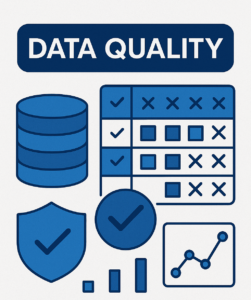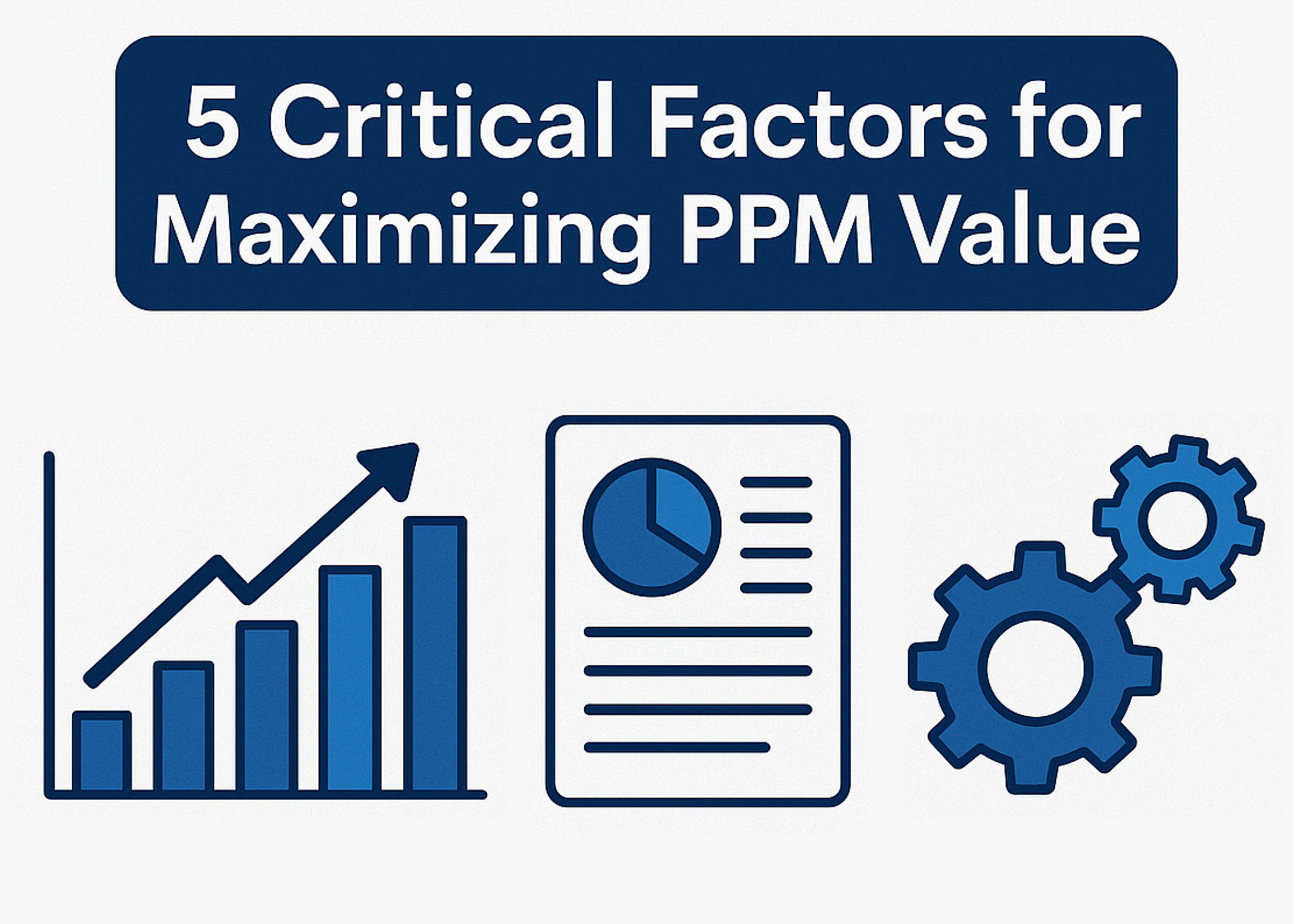5 Critical Factors to Maximize PPM Value
Choosing to leverage a Project Portfolio Management (PPM) platform demonstrates a commitment to organizational maturity. Your PPM system offers advanced capabilities and insights necessary for optimizing the return on your organizational investments of time, money, and limited resources. It holds the potential to produce an efficient flow of information essential in today’s data-driven organizations. Actively ensuring your PPM delivers its full value requires a comprehensive perspective. In this article, Acuity PPM pairs real-world examples with the author’s proven best practices as we explore the 5 most critical factors to maximize PPM value realization. Whether you are proactively ensuring maximum value, or troubleshooting a failing PPM ecosystem, the following article sets forth best practices illustrated by real-world examples to help your organization extract the value you expect from your platform.
As we talk through these critical success factors, Acuity PPM shares relatable examples of companies that were looking to rapidly mature its portfolio management practices. These are companies looking to improve in the areas of resource management, project prioritization, project intake, and executive visibility. In our examples, many of the organizations were rapidly outgrowing spreadsheet-based portfolio management and several required enhanced insights across a hybrid of agile and waterfall methodologies. We’ll talk about how they leveraged the functionality of Acuity PPM to establish best practices and processes, overcoming common pain points and developing maturity roadmaps to generate additional future value.
The 5 Critical Factors to Maximize PPM Value
Our comprehensive approach to maximizing PPM value explores five key elements of the PPM ecosystem:
- Selecting an appropriate tool
- Including the right data
- Business process integration
- Portfolio leadership
- Iterative review
Failure to give proper attention to any one of these critical factors for maximizing PPM value will, at best, result in sub-optimized portfolio management. More commonly, we see companies fail to address these root causes and head toward the ill-informed and costly decision to fully renovate their PPM ecosystem – only to find out their new system is no better than before. We are here to help you break the cycle by addressing the root of these issues and establishing successful practices for your PPM system.
#1 Critical Factor – Select An Appropriate Tool to Maximize PPM Value
As with any software tool, it’s important to carefully understand what the business needs in order to select the right tool that will advance the organization’s practices and maximize PPM value. A maturity assessment, such as Acuity’s PPM Maturity Assessment Calculator can help determine if looking at specialized PPM tools is the right next step for your organization.
When it’s time to select a tool, take the time to consider a range of options. Looking at a range of tool types delivers Goldilocks context to help you find a solution that is just right for your needs. Companies typically need to weigh functionality, cost, security & support, and efficient integration with the other tools they utilize in their day-to-day business activities. Take the time to understand and outline your business needs, to support an objective selection process.
Involve a cross-section of your stakeholders. Arrange a hands-on demo for users to experience the user interface of the tool. Involving users early in the process reveals where your stakeholders will benefit most and can expose interfaces with their business processes. Offering hands-on experience also builds interest and excitement for the selected tool.
Real-world Application
In one example, a company explored a range of possible solutions including large platforms, small platforms, and add-ons to project platforms already used by the organization. Leveraging reputable online technical review forums, they narrowed the search and held demonstrations of products offering the desired functionality. A team of key stakeholders was assembled to collect end-user feedback reflective of the value they required from the platform. The stakeholder group recommended Acuity PPM based on the platform’s best fit for the organization’s functional and cost requirements. Additionally, Acuity’s best-practice structure complimented the company’s priorities along their forward-looking maturity roadmap.
#2 Critical Factor – Data Quality Matters
Start with “Why?”. Whether implementing your PPM or maintaining your platform, focus on the data required to inform portfolio decision-making. Data collection is not free and identifying the most important data used to make decisions is a critical success factor when implementing your PPM system. Avoid the urge to house excess data in your system, as doing so creates inefficiency and confusion. If there are data fields your users insist on collecting, find out why they consider that data important, and what information or context they use it in. This can expose a useful question that need to be answered, or you may come to agree it is an excess or obsolete data field. Stay curious and ask “Why”.
Consider the source. Identify the system of record for each data field you need and understand how that data will make its way into your PPM dataset. For example, if the data relates to resources, such as names, positions, start or termination date, and that data is accurately maintained in the company’s human capital management system, explore opportunities for digital integration. If the data relates to project risks and issues, we might expect project managers to manually input this information over the course of the project. In this case, the PPM serves as the system of record. As we’ll discuss in the next section, when migrating to a PPM platform from spreadsheets or project management systems, organizational change management is critical for ensuring users retire old systems of records and shift to the new centralized system.

Finally, put in the effort to ensure the data flowing into the system is clean, complete, and correct. Before importing historical data, examine the data thoroughly, and address issues or missing data points. Develop clear definitions for data that will be manually input, and leverage system-coded data validation. Acuity PPM offers digital integrations with common project management platforms such as Asana, Monday.com, Jira, and Smartsheet, assuming an organization has established an appropriate degree of foundational portfolio structure to support an integrated flow of project information. Leveraging these automation aids in efficiency and data continuity.
The quality of insights and information generated by your PPM depends heavily on the quality of the data housed within it. Many companies opt for a soft-launch of the platform (for example one or two months) to ensure data inputs are populating appropriately before incorporating the information into regular business operations. Take the time to look for implementation errors in your initial data, as those first impressions by your key stakeholders will set the tone of your adoption efforts. If the data in your system shows errors or isn’t delivering full value at go live, then it’s not time to go live.
Organizations will benefit from carefully identifying the right data needed for the PPM solution, then cleaning and verifying that data prior to loading it into the system. When customizing data fields and dashboards, be sure to focus on generating value-added insights from your precise and clean selection of data.
Real-world Application
Before launching Acuity PPM, an implementation team took the time to explore the types of decisions the PMO leaders were struggling to balance, and the critical data inputs required. They identified the source and method by which these inputs would be populated in the PPM system, and ensured they sourced and cleaned the necessary data for those decisions. After populating the system, they tested it with a select group of end users, identifying and addressing data quality issues before launching the go live with executive stakeholders.
#3 Critical Factor – Value-Generating Integrations
When we talk about integrations, we don’t just mean digital integrations, though you should leverage those whenever possible. In this case, we are talking about integrating the tool and its functionality into the organization’s regular business processes. This is where the tool is designed to deliver real-time value and create the intended benefits and efficiencies. It comes down to good organizational change management, helping your users learn to participate in value creation and utilization.
To extract full value from your PPM platform, your business users must engage with it. Integrating the system with applicable business processes means connecting users to the important value they gain by contributing their data into the PPM systems and referencing it as the portfolio system of record. It also means ensuring decision-makers are confident in accessing the insights in your PPM platform to aid in key portfolio decisions. User-specific training, reference guides, and support sessions help frequent users become familiar with the tool and when their business processes interface with it. Identifying your PPM gurus helps support other users who prefer one-on-one support. Pro-tip: Your Portfolio Manager should be one of these gurus.
In most cases, a PPM vendor is prepared to support the software training, but the customer should provide additional training related to business process integration. Some training focuses on how key stakeholders can leverage and consume insights from the PPM system (i.e. dashboard navigation, context around visualizations, and ensuring an understanding of how the insights feed into their decision-making processes). Creating tailored quick-reference guides for key user groups has helped multiple organizations at the time of launch. Providing white-glove support from an in-house Portfolio Manager is an excellent way to enhance adoption and ensure a positive end-user experience.
One of the most important steps we need to take to ensure the PPM is the single source of portfolio management truth, is to retire old locations that your users were relying on. This can be difficult as human nature resists letting go of legacy systems. Until those systems are retired, the PPM platform will be seen as duplicative “extra input”, and the data redundancy presents a risk for disparate information that degrades trust. One way to support migration to the new platform is to ensure all users who regularly accessed the old location have the appropriate access and training they need to input and retrieve information from the new PPM platform. Helping resistant users gain comfort and excitement about the new system is worth the extra effort.
Real-world Application
In more than one of our example companies, the implementation teams met with user groups to understand when and how each group would interact with the system to retrieve their value-added insights. User group training was tailored to specific audiences both in format and content to maximize the training value. In the cases where we’ve seen the highest rate of adoption, the company locked the legacy system to read-only for historic reference, encouraging transition to the new system for all go-forward PPM activities.
Pro-tip: Find a Senior Portfolio Manager to be one of your PPM gurus
#4 Critical Factor to Maximize PPM Value – Hire An Outstanding Portfolio Manager
A tool is only as phenomenal as its operator. As we say, the tool should support the professional, not the other way around. While portfolio management isn’t rocket science, it’s not an entry-level skill-set by any means. Do not make the mistake of investing in an expensive PPM tool and then assigning a rookie to the role of enterprise Portfolio Manager. The level of expertise you put in this position is exactly the level of quality you’re going to get out of it. Even the hottest PPM platform available would be abandoned after a 3-year initial contract without a seasoned professional at the helm. A strong Project Management Office (PMO) will often have an experienced Portfolio Manager who can fill this need.

An experienced Portfolio Manager knows how to leverage a fully capable PPM system to extract insights to proactively manage the portfolio. They also know how to right-size system utilization to complement and enhance the company’s maturity. This person is in constant communication up and down the organization to ensure users are consistently inputting quality data and extracting information that drives some of the most important decisions in the organization. Portfolio leadership commonly boasts 10-15 years of experience managing all aspects of complex portfolios. A variety of internationally recognized advanced certifications are available in portfolio management (PMI’s PfMP maintains the most robust requirements). Certifications with a requirement for continuing education ensure your Portfolio Manager remains up-to-date on industry best practices.
Great Portfolio Managers enjoy analytics and problem-solving and are especially adept at financial and multi-dimensional scenario analysis. Even as agentic AI becomes prolific in business system toolsets, a knowledgeable professional is indispensable when interpreting and navigating system outputs. As leaders in the organization, their soft skills are equally important when navigating stressful situations, at the same time showing respect for people at all levels of the organization. They are a special leadership breed who can balance strategic thinking with practical execution. Furthermore, an outstanding Portfolio Manager is someone who is deeply invested in and knowledgeable in your selected platform, taking ownership of the value created by those insights. Not everyone is cut out for success in this role, so securing a rockstar Portfolio Manager is a key pillar in organizational success!
You might be asking, if success hinges so much on a first-rate professional, why do I need a PPM system at all? While a high-caliber professional is certainly capable of architecting a rudimentary PPM out of spreadsheets (and believe me, they have all cut their teeth by doing so at some point in their career), supporting your skilled professionals with properly designed systems is a no-brainer equivalent to supporting your accounting department with appropriate accounting software. Project portfolios are a complex form of investment portfolio, and the success of your portfolio is reflected in the success of the company.
Properly staffing this essential role with appropriate knowledge, experience, and an aptitude for strategic analytical thinking allows organizations to fully leverage the suite of functionality housed in their selected PPM.
Real-world Application
A seasoned Portfolio Manager in a maturing organization was involved in the selection and implementation of Acuity PPM. They helped launch system functionalities aligned with the organization’s immediate needs and interests, while working with Acuity to create a roadmap that would aid the company in advancing its maturity goals. The Portfolio Manager achieved a guru-level understanding of the PPM tool, and helped executives and project-leaders access the tool’s value. They facilitated executive review sessions and project team forums, leveraging system insights. As the organization began to mature, they phased in additional functionality to support the company’s portfolio management maturity journey.
In another example, a Portfolio Manager at a multinational food and beverage conglomerate took years of project data captured in spreadsheets and turned it into fresh actionable insights. This kind of expertise will help guide senior leaders to better understand current portfolio conditions (resource capacity) or portfolio investment levels (e.g. Risk-Value bubble chart).

#5 Critical Factor – Iterative Reviews
As with any system, PPMs are not a “set-it and forget-it” undertaking. Left unmanaged (or undermanaged), a PPM platform will appear as a costly burden to the organization rather than an asset. To ensure that you maximize PPM value creation, your Portfolio Manager will periodically apply their curiosity across the elements we’ve discussed above, conducting health-check audits on the system. Here are a few common areas to consider in one of these reviews:
- How has the company matured since the last PPM review?
- Are the business units engaging with the tool as we intended? Are there opportunities to make these interactions more efficient or valuable for company stakeholders?
- Are there any new pain points the organization would like to address that the tool could support?
- Is the data quality remaining high, or are there ways to improve these inputs?
- Are we using the PPM platform as the system of record and source of information for portfolio-related matters?
- Are decisions being informed in real-time by leveraging the PPM dashboards and reports?
- How is the company’s PPM tool designed to support the next phase of the company’s maturity journey?
- What new system capabilities might the organization now be ready to utilize? List out the business processes and users involved in taking this next step, and draft a transition plan and proposal including costs, benefits, proposed timing, and retirement of legacy processes.
- How has the PPM tool changed since the last review? Read the release notes. Keep up on admin training and new enhancement demos produced by your PPM platform vendor. Consider if the company would benefit from bringing these new capabilities online either now or in the near future.
- Develop your roadmap to phase in new benefits that may aid in the company’s maturity journey. Review your implementation roadmap for the next capabilities you plan to leverage, and begin preparing to populate data, align business processes, and make appropriate users aware of subsequent phases of go live.
- Collaborate with your PPM platform vendor to share feedback and enhancement requests.
Create a scorecard or health check to aid discussion of user compliance, feature availability, and other matters discovered in the review. Maintain a forward-looking perspective knowing that all businesses do their best, but leveraging full value from a system requires ongoing active support. Acuity PPM offers a wealth of resources to Portfolio Managers in support of iterative reviews through their community space.
Real-world Application
A Portfolio Manager conducted semi-annual success audits with the company and vendor to identify areas of successful value realization and areas that needed attention. The Portfolio Manager served as the business unit administrator for the PPM tool, championing new functionality for consideration by the company as aligned to their value expectations. The Portfolio Manager was able to gauge stakeholder satisfaction and success in real-time through their involvement in the day-to-day portfolio activities with project teams, and through delivering information to business leaders. As the company began adopting more best practices, the team built a two-year maturity roadmap with opportunities to fast-track features depending on executive direction. By partnering with Acuity PPM, the company was able to influence the software development roadmap by contributing their highest-priority functionality needs through Acuity’s enhancement request process.
Conclusion
Whether implementing a PPM platform for the first time or refreshing your processes to maximize PPM value, be sure to give full consideration to these five critical factors for success. Failure in any one area creates ripples that can disrupt your PPM ecosystem. Acuity PPM and Prelude Strategy Consulting are adept at navigating these nuances to help organizations address the root cause and achieve the full value of your PPM platform and processes.
About the Author
Carol Laird is a principal consultant with Prelude Strategy Consulting contributes her expertise in portfolio management best practices. Her experience includes over 20 years of project and strategic portfolio management, with formal studies culminating in MBA and PMP credentials. She works with large and small clients to increase maturity and resolve pain points related to strategy portfolio design and delivery.

Never miss an Acuity PPM article
Don't take our word, listen to what others are saying:
"I find value in all of your articles."
"Your articles are interesting and I am sharing them with my team who have limited project knowledge. They are very useful."


